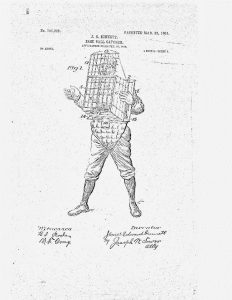Although people do not normally associate patent law with baseball, many of the edge-of-your-seat moments and walk-off homers would not be around today if it were not for patented technology. Let’s take a look at how patents have allowed us to play ball!
What is a Patent?
Patents are a form of intellectual property. They are issued by individual countries. In the United States, the United States Patent and Trademark Office (USPTO) grants patents to patent applications that meet the relevant criteria. A patent gives the owner—whether the original inventor, or someone the inventor assigns his/her rights to (such as an employer)—the right to exclude others from “making, using, offering for sale, or selling the invention throughout the United States or importing the invention into the United States.” The right generally lasts for 20 years from the time the application for the patent is filed, but does not begin until the patent actually issues.
In the U.S., patents are issued for products and processes as long as they are new, useful, and nonobvious. Certain things are barred from being patented, such as natural phenomena, laws of nature, and abstract ideas.
Article I, Section 8, Clause 8 of the U.S. Constitution grants the government power to issue patents. One justification for issuing patents is to reward the inventor for providing something useful to society by awarding a limited monopoly. This limited monopoly may be used to incentivize inventors to continue to make advancements in their respective fields.
Let’s Play Catch
An essential piece of equipment to baseball players today is the baseball glove. At first, gloves were considered “unmanly” and therefore not worn by early players, leaving them with bruised hands and broken fingers. Over time this stigma was broken and glove technology began to evolve.
One of the first patents on a baseball glove was granted to George Rawlings in 1885 (Pat. No. 325,968). The glove looked very similar to a typical everyday glove, and not like the baseball mitts used today. Advancements were made in 1891 by Harry Decker (Pat. No. 450,366) and Bob Reach (Pat. No. 450,717) by adding cushioning to the gloves. The classic “pillow-style” catcher’s mitt came about in 1895 (Pat. No. 528,343).
One of the more bizarre patents on catching equipment came in 1904. James Bennet created the “Base Ball Catcher” (Pat. No. 755,209). This catching apparatus worked by strapping a cage to the front of one’s torso and acting as a target to catch the ball. Imagine catchers wearing a cage while squatting behind a batter . . . needless to say, the invention struck out.
Batter Up!
Bats have remained relatively unchanged from the early days of baseball. In 1884, William Gray obtained a patent for a baseball bat with a roughened handle to help with a batter’s grip (Pat. No. 300,360).
 As the founder of Hillerich & Bradsby Co., the manufacturer of the Louisville Slugger, John Hillerich owned many patents on baseball bats. One such patent was on a process of hardening the surface of a bat to allow for balls to be hit much longer distances (Pat. No. 716,541). Another patent, which did not get incorporated into the modern game, was a bat with a textured barrel to modify the direction of a batted ball (Pat. No. 771,247). Yet another strange patent that is not featured in today’s game was the curved bat (Pat. No. 430,388). The bat included a large curve near the end of the barrel to put greater spin on a batted ball.
As the founder of Hillerich & Bradsby Co., the manufacturer of the Louisville Slugger, John Hillerich owned many patents on baseball bats. One such patent was on a process of hardening the surface of a bat to allow for balls to be hit much longer distances (Pat. No. 716,541). Another patent, which did not get incorporated into the modern game, was a bat with a textured barrel to modify the direction of a batted ball (Pat. No. 771,247). Yet another strange patent that is not featured in today’s game was the curved bat (Pat. No. 430,388). The bat included a large curve near the end of the barrel to put greater spin on a batted ball.
You’re Out!
Before the debate about using an electronic strike zone started, patents were granted on technologies designed to aid umpires. In 1875, John C. O’Neil patented a base with a bell (Pat. No. 171,038). As the base runner would step on the base, the bell would ring providing an auditory signal for the umpire to  use to determine if the runner was safe or out. Expanding on this idea, John M. Humphreys patented an electronic base system in 1903 (Pat. No. 727,633). The system included a series of circuits set up across the infield but was too technologically complicated to be adopted by the league.
use to determine if the runner was safe or out. Expanding on this idea, John M. Humphreys patented an electronic base system in 1903 (Pat. No. 727,633). The system included a series of circuits set up across the infield but was too technologically complicated to be adopted by the league.
Rounding Third, Heading for Home…
Although some patents were clearly a swing and a miss, as you can see, patents have always played a part in our national pastime. This will continue to be true as baseball evolves during the technology age, where decisions are driven more and more by analytics. Just remember the next time you are at a game, be aware of foul balls . . . and for the next big invention coming to a ballpark near you.

Damyan Kolomayets
Associate Blogger
Loyola University Chicago School of Law, JD 2021
